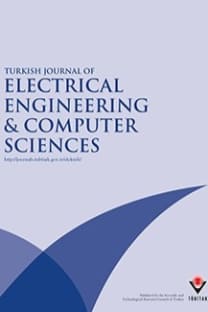Analysis of a rule-based curriculum plan optimization system with Spearman rank correlation
Genetic algorithm, rule base, curriculum plan optimization, Spearman rank correlation
Analysis of a rule-based curriculum plan optimization system with Spearman rank correlation
___
- S. Petrovic, E.K. Burke, “University timetabling” in: Handbook of Scheduling: Algorithms, Models and Performance Analysis (J.Y.T. Leung, editor), Boca Raton, FL, USA, CRC Press, pp. 45-1–46-1, 2004.
- R. Qu, E.K. Burke, B. McCollum, L.T. Merlot, S.Y. Lee, “A survey of search methodologies and automated approaches for examination timetabling”, Journal of Scheduling, Vol. 12, pp. 55–89, 2009.
- N. Pillay, W. Banzhaf, “An informed genetic algorithm for the examination timetabling problem”, Applied Soft Computing, Vol. 10, pp. 457–467, 2010.
- C ¸ .H. Alada˘ g, G. Hocao˘ glu, M.A. Ba¸saran, “The effect of neighbourhood structures on tabu search algorithm in solving course timetabling problem”, Expert Systems with Applications, Vol. 36, pp. 12349–12356, 2009.
- H.J. Holland, Adaptation in Natural and Artificial Systems, Cambridge, MA, USA, MIT Press, 1975.
- D.E. Goldberg, Genetic Algorithms in Search, Optimization and Machine Learning, Boston, MA, USA, Addison Wesley, 1989.
- P.C. Chang, J.C. Hsieh, S.H. Chen, J.L. Lin, W.H. Huang, “Artificial chromosomes embedded in genetic algorithm for a chip resistor scheduling problem in minimizing the makespan”, Expert Systems with Applications, Vol. 36, pp. 7135–7141, 2009.
- C.C. Tsai, S.H.A. Li, “A two-stage modeling with genetic algorithms for the nurse scheduling problem”, Expert Systems with Applications, Vol. 36, pp. 9506–9512, 2009.
- J. Giarratano, G. Riley, Expert Systems: Principles and Programming, 4th ed., Boston, MA, USA, Course Technology, 2004.
- N. Verma, Y. Jindal, R. Aggarwal, S. Jain, “An approach towards designing of car troubleshooting expert system”, International Journal of Computer Applications, Vol. 1, pp. 65–67, 2010.
- L. Chaoan, “The expert system of product design based on CBR and GA”, IEEE International Conference on Computational Intelligence and Security Workshops, pp. 144–147, 2007.
- J.S. Chou, “Generalised linear model-based expert system for estimating the cost of transportation projects”, Expert Systems with Applications, Vol. 36, pp. 4253–4267, 2009.
- Y. Kuroki, G.S. Young, S.E. Haupt, “UAV navigation by an expert system for contaminant mapping with a genetic algorithm”, Expert System with Applications, Vol. 37, pp. 4687–4697, 2010.
- W.K. Wong, X.H. Zeng, W.M.R. Au, “A decision support tool for apparel coordination through integrating the knowledge-based attribute evaluation expert system and the T-S fuzzy neural network”, Expert Systems with Applications, Vol. 36, pp. 2377–2390, 2009.
- J.S. Kim, “Development of a user-friendly expert system for composite laminate design”, Composite Structures, Vol. 79, pp. 76–83, 2007.
- S. Chakravorty, M. Thukral, “Choosing distribution substation location using soft computing technique”, Proceedings of International Conference on Advances in Computing, Communication and Control, ACM, pp. 53–55, 200 D. Abidin, S ¸. C ¸ akır, “Rule-based genetic algorithm for in-service training curriculum plan”, Proceedings of the International Conference on Computers, Digital Communications and Computing, pp. 160–166, 2011.
- S. Ballı, B. Karasulu, A. U˘ gur, S. Koruko˘ glu, “Neuro-fuzzy decision support system for selecting players in basketball”, Journal of ˙Istanbul Technical University, Vol. 8, pp. 15–25, 2009.
- F. Garc´ıa-Camacho, J.J. Gallardo-Rodr´ıguez, A. S´ anchez-Mir´ on, Y. Christi, E. Molina-Grima, “Genetic algorithm based medium optimization for a toxic dinoflagellate microalga”, Harmful Algae, Vol. 10, pp. 697–701, 2011. M.H. Tseng, S.J. Chen, G.H. Hwang, M.Y. Shen, “A genetic algorithm rule-based approach for land-cover classification”, ISPRS Journal of Photogrammetry & Remote Sensing, Vol. 63, pp. 202–212, 2008.
- J.J. Greffenstette, J.E. Baker, “How genetic algorithms work: a critical look at implicit parallelism”, Proceedings of the 3rd International Conference on Genetic Algorithms, Morgan Kaufmann Publishers, pp. 20–27, 1989. O. Roeva, “Improvement of genetic algorithm performance for identification of cultivation process models”, 9th WSEAS International Conference on Evolutionary Computing, pp. 34–39, 2008.
- D.J. Sheskin, Handbook of Parametric and Non-Parametric Statistical Procedures, 2nd ed., London, Chapman & Hall/CRC, pp. 870–872, 2000.
- V.L. Bissonette, “Critical values of the t distribution”, Mt Berry, GA, USA, Berry College, available online at http://facultyweb.berry.edu/vbissonnette/tables/t.pdf, 2011.
- ISSN: 1300-0632
- Yayın Aralığı: Yılda 6 Sayı
- Yayıncı: TÜBİTAK
Coherence analysis on thermal effect for power cables under different environmental conditions
Sezai TAŞKIN, Şahin Serhat ŞEKER, Özcan KALENDERLİ, Murat KARAHAN
RFID and communication technologies for an intelligent bus monitoring and management system
Mahammad Abdul HANNAN, Aishah MUSTAPHA, Abdulla AL MAMUN, Aini HUSSAIN, Hassan BASRI
Mohamed BENCHAGRA, Mohamed MAAROUFI, Mohammed OUASSAID
Statistical approach for determining impulse breakdown voltage distribution under DC sweep voltage
Tow Leong TIANG, Dahaman ISHAK
A web laboratory using MATLAB Builder NE for computer image processing
Sezgin KAÇAR, Cüneyt BAYILMIŞ, Özdemir ÇETİN
Abas Ali ZAMANI, Ehsan BIJAMI, Farid SHEIKHOLESLAM
HD-MR: a new algorithm for number recognition in electrical meters
Miguel RODRÍGUEZ, Geovanni BERDUGO, Daladier JABBA, Maria CALLE, Miguel JIMENO
A low-memory intensive decoding architecture for double-binary convolutional turbo code
